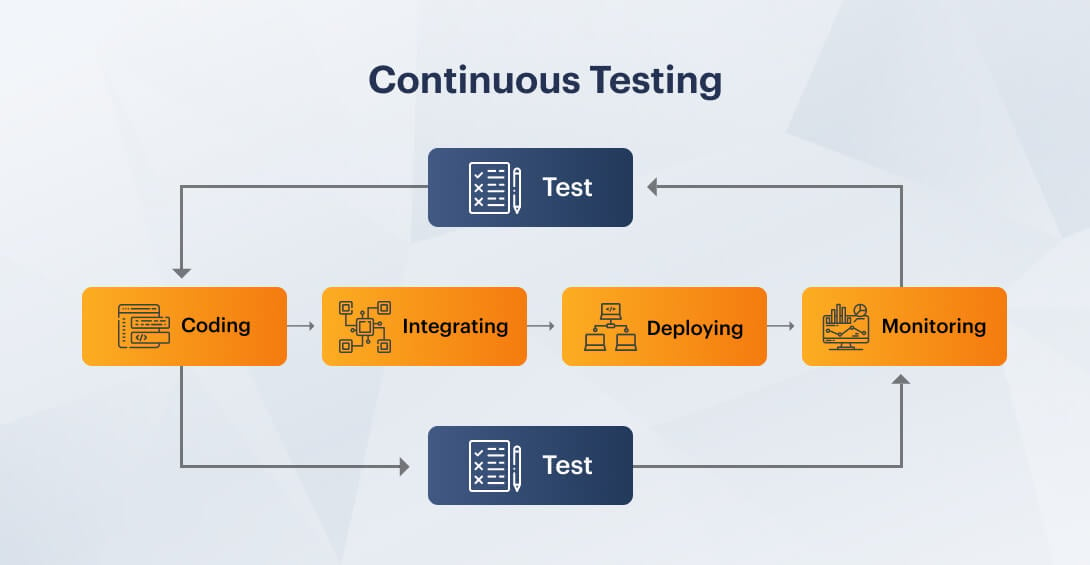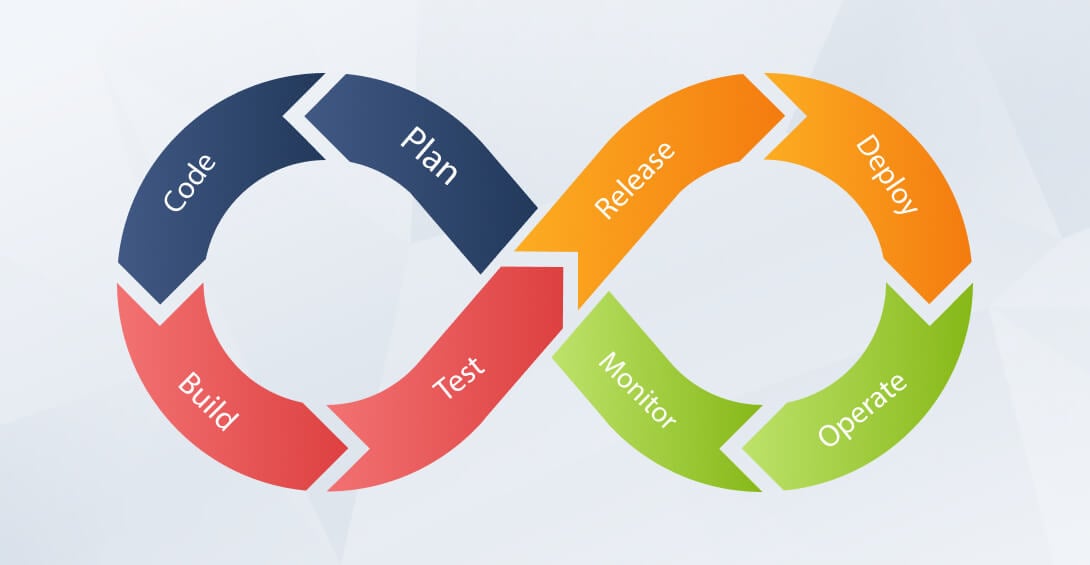-
Continuous Testing - Defined
-
How is Continuous Testing different from Traditional Testing?
- Benefits of Continuous Testing
- How is continuous testing performed?
-
Qualities to look for in DevOps testing tools
- Significant challenges faced during continuous testing
-
How to resolve the challenges
-
To conclude
Continuous testing has become an essential element of digital transformation because it brings authenticity to the business processes, refines business assets as well as improves the standard testing quality maintained across the industry. With the increasing need for high-quality software and quick launch time to market, companies have started embracing DevOps methodologies, and continuous testing is a significant part of that process. So let us understand what continuous testing is and how it is helpful for the software development life cycle.
Expand your business with our offshore resources
Continuous Testing – Defined

Continuous Testing in DevOps is the uninterrupted process of constant testing at every stage of the Software Development Lifecycle (SDLC). This waterfall procedure involves automated tests at various levels whenever there is a change in the code. These tests conducted along the software development pipeline evaluate the quality of the software and improve speed and efficiency during deployments.
Continuous testing fixes bugs as soon as they are found, which is one of the critical and most rewarding aspects of testing continuously in DevOPs.
How is Continuous Testing different from Traditional Testing?
Traditional testing usually involves handing over of software from the development team to the Quality Assurance team. Once the software is handed over to the QA team, they evaluate the software extensively. However, this takes a lot of time to deliver the product, though the product quality is guaranteed.
On the other hand, Continuous Testing identifies bugs in the software at the same time when the new code is generated so the bug can be fixed then and there. This kind of testing shortens the delivery cycle of the software without compromising on the quality. The end product is therefore consistently robust.
The demand for a speedy development life cycle has eliminated the traditional development and testing practice in phases. Most enterprises are now adapting to this new methodology where the responsibilities are shared, and incremental activities are performed continuously. DevOps and DevSecOps are two such practices that have helped increase the development velocity. Continuous testing in DevOps and DevSecOps has made the agile way of working more convenient because, unlike traditional testing, the code continuously moves from development to testing to deployment phases.
Benefits of Continuous Testing
Continuous testing in DevOps provides multiple benefits to companies:
1. Quick bug discovery and remedy
Continuous testing helps break down the complexities in multilayered architectures by utilizing an automated and scalable testing solution.
2. Helps bring consistency in code
Continuous code testing improves the quality of software delivered, bringing a similar level of code maintenance throughout the procedure. With continuous integration, the system and its parts remain consistent, increasing the quality of deployments.
3. Accelerate releases and higher efficiency
Continuous testing allows automation of quality assurance and quality interoperation. Integrating feedback loops into user and unit testing modules helps developers get insight to improve the code performance and compatibility before deploying.
4. Continuous Testing brings more transparency
Since the code is tested right from the beginning, developers and testers have a clear idea of each development and update in the software development process. The team always gets intimated whether the code worked or failed in the tests conducted through the automation tools that give 99% accurate results.
5. Enhanced user experience
The new and advanced testing methods can imitate a variety of use cases and help developers analyze how users will react to the particular scenario. The results gathered from these reports help developers fix the UI’s inconsistencies before to avoid any issues during or after the deployment.
How is continuous testing performed?

Small sections of codes are tested continuously. Even though API and GUI tests are automated and integrated into the Continuous Integration Agent, these tests depend on interfaces, test data, and environment fulfillment before execution.
Creation of virtual environments
In order to perform continuous testing successfully, all the environments must be up and running all the time for constant testing. The challenge here is that it is not possible to keep multiple domains running all the time. Therefore, in order to test code, virtual environments must be created that allow the testing of code at all times.
Create an anonymous test database
Since continuous testing will require the database at its disposal, a synthetic database must be created to perform continuous testing, which protects the data breach and maintains confidentiality with no original information at risk.
Reliable test automation
Continuous testing can only be performed effectively using automation tools for DevOps. Some of the best automation testing tools that deliver the best results are:
#Jenkins
Jenkins is a leading open-source integration tool made in Java that lets developers build, test, and deploy software. GIA interface and console commands can be configured to this tool.
#Travis
Hosted by Github, this continuous testing tool offers on-premise variants and offers multiple languages for the software to build conveniently.
#Selenium
Selenium is best for web application testing and is an open-source testing tool that supports Chrome, Firefox, and other well-known browsers.
#Query Surge
Query surge is an advanced testing tool created primarily to automate the testing of Big Data and Data Warehouses. This tool keeps the data intact in the target store by constantly checking and notifying any differences in the data.
Qualities to look for in DevOps testing tools
- Look for planning tools that come with functionalities to check user stories and tasks.
- Your software development tool must be able to carry out Unit and Functional Automation tests using the source code.
- A version control system is a necessity and one of the essential features that a testing tool must provide as it lets you communicate and track source code versions.
Significant challenges faced during continuous testing
The increasing demand to improve software delivery time has led the companies to follow DevOps and Agile methodologies. Due to this, Quality Analysts and testers have to adapt themselves to advanced testing tools and environments like – Continuous testing. Though continuous testing proves to be the fastest way of delivering the solution, it comes with its own challenges. Some of them are mentioned below:
1. Lack of proper testing tools
Lack of test automation tools causes the testing team to struggle with the tools and framework. Since many products don’t have standard tools for continuous testing, product teams often have to work with the in-house automation tools/frameworks that are usually not appropriately documented. Even if you attempt to make changes in the tool, it may cost your resources and time, which is typically impossible when the team has to deliver the product in a specific timeframe.
2. Test data management causes trouble
Locating accurate test data is the biggest challenge in continuous delivery. If the test data management is done correctly, the team’s overall efficiency can be increased. The main issue with test data management is the extraction of all the data spread across multiple databases and very limited access to production systems. Maintenance of different versions of data for different kinds of testing without copying the production data is again a challenge.
3. Absence of feedback loops
To use continuous testing, feedback loops must be incorporated into the system to get real-time feedback. Lack of such feedback loops can lead to a delay in action. Feedback loops are necessary because they give alert messages if a bug is found. It also helps in getting the product’s performance metrics as it provides a real-time performance dashboard. Lack of these feedbacks can lead to poor product quality.
4. Multiple test data versions creation
Locally stored test data for testing environments can lead to various test data versions. Keeping all the test data into a repository and using it for different testing environments can eliminate this issue. This may cause network delays, though.
5. Scalability problem due to improper tool
Continuous testing gets hindered if there is no proper support for ongoing test sessions, which may lead to slow executions of tests. If the tool has such issues to accommodate test session data, the system may slow down due to overload, delaying the entire process. Moreover, you can’t switch to another tool midway.
6. Insufficient testers for Continuous testing
Continuous testing creates an immense workload for testers because it is a constant process and requires a lot of investment to set up the process. Testers find it hard to balance between the efforts required to set up continuous testing and the tasks that require traditional testing, which are generally of high priority. This leads to backlogs and time crunch for carrying out continuous testing.
How to resolve the challenges
- Assess the tools and frameworks before using them in the system.
- Product features must be checked for the testability support needed to carry out continuous testing.
- Continuous testing requires a big budget for tools and frameworks. Considering the funding will help you make correct decisions.
- Make use of distributed systems.
- Maintain a central repository for testing data and to avoid scalability issues.
- Make use of cloud-based virtual environments that help resolve availability issues of test environments.
- Must have a bigger team of testers for a smooth transition from traditional testing to continuous testing.
To conclude
Continuous testing is the best way to quickly bring the software to market because it allows real-time testing during code production. This practice eliminates issues right away, which otherwise could lead to a delayed software development life cycle. Therefore adapting to continuous testing practice can help businesses deliver premium product quality well before the estimated time.
However, it does have its own set of challenges that must be addressed before adapting to continuous testing. You must automate test design, orchestration, and execution and use a device cloud that allows unlimited testing data storage.








